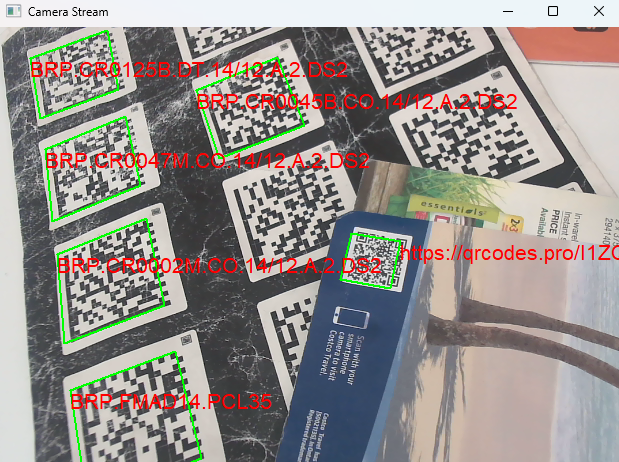构建 Python 相机 SDK 并使用它进行多条码扫描
来源:dev.to
时间:2025-01-09 17:33:29 417浏览 收藏
今日不肯埋头,明日何以抬头!每日一句努力自己的话哈哈~哈喽,今天我将给大家带来一篇《构建 Python 相机 SDK 并使用它进行多条码扫描》,主要内容是讲解等等,感兴趣的朋友可以收藏或者有更好的建议在评论提出,我都会认真看的!大家一起进步,一起学习!
现在,轻量级 c 相机 sdk 已针对 windows、linux 和 macos 完成,我们可以将其集成到其他高级编程语言中。在本文中,我们将探讨如何基于 c 相机库构建 python 相机 sdk,并使用它与 dynamsoft barcode reader sdk 进行多条码扫描。
python 多条码扫描仪演示视频
搭建 cpython 扩展项目的脚手架
cpython 扩展是一个共享库(例如,windows 上的 dll、linux 上的 .so 或 macos 上的 .dylib)可以在运行时加载到python解释器中并用于扩展其功能。 lite相机cpython扩展项目的结构如下:
python-lite-camera │ │── include │ ├── camera.h │ ├── camerapreview.h │ ├── stb_image_write.h │── lib │ ├── linux │ │ ├── liblitecam.so │ ├── macos │ │ ├── liblitecam.dylib │ ├── windows │ │ ├── litecam.dll │ │ ├── litecam.lib ├── src │ ├── litecam.cpp │ ├── pycamera.h │ ├── pywindow.h │── litecam │ ├── __init__.py │── setup.py │── manifest.in │── readme.md
说明:
- include:c 相机库的头文件。
- lib:c 相机库的共享库。
- src:python相机sdk的源代码。
- litecam:python 扩展的入口点。
- setup.py:构建脚本。
- manifest.in:包含非python文件的清单文件。
- readme.md:文档。
为 python 扩展编写构建脚本 setup.py
在setup.py中添加以下内容:
from setuptools.command import build_ext
from setuptools import setup, extension
import sys
import os
import io
from setuptools.command.install import install
import shutil
from pathlib import path
lib_dir = ''
sources = [
"src/litecam.cpp",
]
include_dirs = [os.path.join(os.path.dirname(__file__), "include")]
libraries = ['litecam']
extra_compile_args = []
if sys.platform == "linux" or sys.platform == "linux2":
lib_dir = 'lib/linux'
extra_compile_args = ['-std=c++11']
extra_link_args = ["-wl,-rpath=$origin"]
elif sys.platform == "darwin":
lib_dir = 'lib/macos'
extra_compile_args = ['-std=c++11']
extra_link_args = ["-wl,-rpath,@loader_path"]
elif sys.platform == "win32":
lib_dir = 'lib/windows'
extra_link_args = []
else:
raise runtimeerror("unsupported platform")
long_description = io.open("readme.md", encoding="utf-8").read()
module_litecam = extension(
"litecam",
sources=sources,
include_dirs=include_dirs,
library_dirs=[lib_dir],
libraries=libraries,
extra_compile_args=extra_compile_args,
extra_link_args=extra_link_args,
)
def copyfiles(src, dst):
if os.path.isdir(src):
filelist = os.listdir(src)
for file in filelist:
libpath = os.path.join(src, file)
shutil.copy2(libpath, dst)
else:
shutil.copy2(src, dst)
class custombuildext(build_ext.build_ext):
def run(self):
build_ext.build_ext.run(self)
dst = os.path.join(self.build_lib, "litecam")
copyfiles(lib_dir, dst)
filelist = os.listdir(self.build_lib)
for file in filelist:
filepath = os.path.join(self.build_lib, file)
if not os.path.isdir(file):
copyfiles(filepath, dst)
os.remove(filepath)
class custombuildextdev(build_ext.build_ext):
def run(self):
build_ext.build_ext.run(self)
dev_folder = os.path.join(path(__file__).parent, 'litecam')
copyfiles(lib_dir, dev_folder)
filelist = os.listdir(self.build_lib)
for file in filelist:
filepath = os.path.join(self.build_lib, file)
if not os.path.isdir(file):
copyfiles(filepath, dev_folder)
class custominstall(install):
def run(self):
install.run(self)
setup(name='lite-camera',
version='2.0.1',
description='litecam is a lightweight, cross-platform library for capturing rgb frames from cameras and displaying them. designed with simplicity and ease of integration in mind, litecam supports windows, linux and macos platforms.',
long_description=long_description,
long_description_content_type="text/markdown",
author='yushulx',
url='https://github.com/yushulx/python-lite-camera',
license='mit',
packages=['litecam'],
ext_modules=[module_litecam],
classifiers=[
"development status :: 5 - production/stable",
"environment :: console",
"intended audience :: developers",
"intended audience :: education",
"intended audience :: information technology",
"intended audience :: science/research",
"license :: osi approved :: mit license",
"operating system :: microsoft :: windows",
"operating system :: macos",
"operating system :: posix :: linux",
"programming language :: python",
"programming language :: python :: 3",
"programming language :: python :: 3 :: only",
"programming language :: python :: 3.6",
"programming language :: python :: 3.7",
"programming language :: python :: 3.8",
"programming language :: python :: 3.9",
"programming language :: python :: 3.10",
"programming language :: python :: 3.11",
"programming language :: python :: 3.12",
"programming language :: c++",
"programming language :: python :: implementation :: cpython",
"topic :: scientific/engineering",
"topic :: software development",
],
cmdclass={
'install': custominstall,
'build_ext': custombuildext,
'develop': custombuildextdev},
)
说明:
- lite-camera:python 包的名称。
- ext_modules:cpython 扩展列表。它指定不同平台的源文件、包含目录、库目录、库以及编译/链接标志。
- 开发:用于开发的自定义命令。它将共享库复制到 litecam 文件夹以方便测试。
- build_ext:自定义构建过程,将共享库打包到wheel包中。
用 c 实现 python camera sdk api
pycamera.h 文件定义了用于从相机捕获帧的 pycamera python 类,而 pywindow.h 文件定义了用于在窗口中显示帧的 pywindow python 类。 litecam.cpp 文件作为 python 扩展的入口点,其中定义了一些全局方法,并注册了 pycamera 和 pywindow 类。
pycamera.h
包括
#include <python.h> #include <structmember.h> #include "camera.h"
- python.h:包含使用 python c api。
- structmember.h:提供用于管理对象成员的宏和帮助器。
- camera.h:定义 camera 类,pycamera 扩展对其进行包装。
pycamera 结构体定义
typedef struct
{
pyobject_head camera *handler;
} pycamera;
pycamera 结构体表示包装 c camera 对象的 python 对象。该处理程序是一个指向 camera 类实例的指针。
方法
-
pycamera_dealloc
8556677774455解除分配 camera 对象并释放关联的内存。
-
pycamera_new
static pyobject *pycamera_new(pytypeobject *type, pyobject *args, pyobject *kwds) { pycamera *self; self = (pycamera *)type->tp_alloc(type, 0); if (self != null) { self->handler = new camera(); } return (pyobject *)self; }创建 pycamera 的新实例。它为python对象分配内存,创建一个新的camera对象,并将其分配给self->handler。
-
开放
static pyobject *open(pyobject *obj, pyobject *args) { pycamera *self = (pycamera *)obj; int index = 0; if (!pyarg_parsetuple(args, "i", &index)) { return null; } bool ret = self->handler->open(index); return py_buildvalue("i", ret); }打开指定索引的相机。
-
列表媒体类型
static pyobject *listmediatypes(pyobject *obj, pyobject *args) { pycamera *self = (pycamera *)obj; std::vector<mediatypeinfo> mediatypes = self->handler->listsupportedmediatypes(); pyobject *pylist = pylist_new(0); for (size_t i = 0; i < mediatypes.size(); i++) { mediatypeinfo &mediatype = mediatypes[i]; #ifdef _win32 pyobject *subtypename = pyunicode_fromwidechar(mediatype.subtypename, wcslen(mediatype.subtypename)); pyobject *pymediatype = py_buildvalue("{s:i,s:i,s:o}", "width", mediatype.width, "height", mediatype.height, "subtypename", subtypename); if (subtypename != null) { py_decref(subtypename); } #else pyobject *pymediatype = py_buildvalue("{s:i,s:i,s:s}", "width", mediatype.width, "height", mediatype.height, "subtypename", mediatype.subtypename); #endif pylist_append(pylist, pymediatype); } return pylist; }返回支持的媒体类型列表。对于 windows,它将宽字符串转换为 python unicode 对象。
-
发布
static pyobject *release(pyobject *obj, pyobject *args) { pycamera *self = (pycamera *)obj; self->handler->release(); py_return_none; }释放相机。
-
设置分辨率
static pyobject *setresolution(pyobject *obj, pyobject *args) { pycamera *self = (pycamera *)obj; int width = 0, height = 0; if (!pyarg_parsetuple(args, "ii", &width, &height)) { return null; } int ret = self->handler->setresolution(width, height); return py_buildvalue("i", ret); }设置相机的分辨率。
-
捕获帧
static pyobject *captureframe(pyobject *obj, pyobject *args) { pycamera *self = (pycamera *)obj; framedata frame = self->handler->captureframe(); if (frame.rgbdata) { pyobject *rgbdata = pybytearray_fromstringandsize((const char *)frame.rgbdata, frame.size); pyobject *pyframe = py_buildvalue("iiio", frame.width, frame.height, frame.size, rgbdata); releaseframe(frame); return pyframe; } else { py_return_none; } }从相机捕获帧并将 rgb 数据作为 python 字节数组返回。
-
getwidth 和 getheight
static pyobject *getwidth(pyobject *obj, pyobject *args) { pycamera *self = (pycamera *)obj; int width = self->handler->framewidth; return py_buildvalue("i", width); } static pyobject *getheight(pyobject *obj, pyobject *args) { pycamera *self = (pycamera *)obj; int height = self->handler->frameheight; return py_buildvalue("i", height); }返回捕获帧的宽度和高度。
实例方法
static pymethoddef instance_methods[] = {
{"open", open, meth_varargs, null},
{"listmediatypes", listmediatypes, meth_varargs, null},
{"release", release, meth_varargs, null},
{"setresolution", setresolution, meth_varargs, null},
{"captureframe", captureframe, meth_varargs, null},
{"getwidth", getwidth, meth_varargs, null},
{"getheight", getheight, meth_varargs, null},
{null, null, 0, null}};
定义 pycamera python 对象上可用的方法。这些方法与上面定义的相应 c 函数相关联。
pycamera类型
static pytypeobject pycameratype = {
pyvarobject_head_init(null, 0) "litecam.pycamera", /* tp_name */
sizeof(pycamera), /* tp_basicsize */
0, /* tp_itemsize */
(destructor)pycamera_dealloc, /* tp_dealloc */
0, /* tp_print */
0, /* tp_getattr */
0, /* tp_setattr */
0, /* tp_reserved */
0, /* tp_repr */
0, /* tp_as_number */
0, /* tp_as_sequence */
0, /* tp_as_mapping */
0, /* tp_hash */
0, /* tp_call */
0, /* tp_str */
pyobject_genericgetattr, /* tp_getattro */
pyobject_genericsetattr, /* tp_setattro */
0, /* tp_as_buffer */
py_tpflags_default | py_tpflags_basetype, /*tp_flags*/
"pycamera", /* tp_doc */
0, /* tp_traverse */
0, /* tp_clear */
0, /* tp_richcompare */
0, /* tp_weaklistoffset */
0, /* tp_iter */
0, /* tp_iternext */
instance_methods, /* tp_methods */
0, /* tp_members */
0, /* tp_getset */
0, /* tp_base */
0, /* tp_dict */
0, /* tp_descr_get */
0, /* tp_descr_set */
0, /* tp_dictoffset */
0, /* tp_init */
0, /* tp_alloc */
pycamera_new, /* tp_new */
};
定义 pycamera 类型,包括其方法、内存分配、释放和其他行为。
pywindow.h
包括
#include <python.h> #include <structmember.h> #include "camerapreview.h"
- python.h:使用 python c api 所需的。
- structmember.h:提供管理对象成员的宏。
- camerapreview.h:定义camerawindow类,用于显示相机预览并与其交互。
pywindow 结构体定义
typedef struct
{
pyobject_head camerawindow *handler;
} pywindow;
定义一个包装 c camerawindow 对象的 pywindow 结构体。 handler 成员指向 camerawindow 的一个实例。
pywindow 对象的方法
-
pywindow_dealloc
static int pywindow_clear(pywindow *self) { if (self->handler) { delete self->handler; } return 0; } static void pywindow_dealloc(pywindow *self) { pywindow_clear(self); py_type(self)->tp_free((pyobject *)self); }取消分配camerawindow对象并释放内存。
-
pywindow_new
static pyobject *pywindow_new(pytypeobject *type, pyobject *args, pyobject *kwds) { pywindow *self; int width = 0, height = 0; char *title = null; if (!pyarg_parsetuple(args, "iis", &width, &height, &title)) { return null; } self = (pywindow *)type->tp_alloc(type, 0); if (self != null) { self->handler = new camerawindow(width, height, title); if (!self->handler->create()) { std::cerr << "failed to create window." << std::endl; return null; } self->handler->show(); } return (pyobject *)self; }创建 pywindow 的新实例。它为python对象分配内存,创建一个新的camerawindow对象,并将其分配给self->handler。
-
等待键
static pyobject *waitkey(pyobject *obj, pyobject *args) { pywindow *self = (pywindow *)obj; const char *key = null; if (!pyarg_parsetuple(args, "s", &key) || strlen(key) != 1) { pyerr_setstring(pyexc_valueerror, "expected a single character string"); return null; } bool ret = self->handler->waitkey(key[0]); return py_buildvalue("i", ret); }等待按键事件,如果按键与指定字符匹配则返回 false。 false 意味着应用程序应该退出。
-
showframe
static pyobject *showframe(pyobject *obj, pyobject *args) { pywindow *self = (pywindow *)obj; int width = 0, height = 0; pyobject *bytearray = null; if (!pyarg_parsetuple(args, "iio", &width, &height, &bytearray)) { return null; } unsigned char *data = (unsigned char *)pybytearray_asstring(bytearray); self->handler->showframe(data, width, height); py_return_none; }在窗口中显示一个框架。
-
绘制轮廓
static pyobject *drawcontour(pyobject *obj, pyobject *args) { pywindow *self = (pywindow *)obj; pyobject *pypoints = null; if (!pyarg_parsetuple(args, "o", &pypoints)) { return null; } std::vector<std::pair<int, int>> points; for (py_ssize_t i = 0; i < pylist_size(pypoints); i++) { pyobject *item = pylist_getitem(pypoints, i); int x = pylong_aslong(pytuple_getitem(item, 0)); int y = pylong_aslong(pytuple_getitem(item, 1)); points.push_back(std::make_pair(x, y)); } self->handler->drawcontour(points); py_return_none; }在框架上绘制轮廓(一系列点)。
-
绘制文本
static pyobject *drawtext(pyobject *obj, pyobject *args) { pywindow *self = (pywindow *)obj; const char *text = null; int x = 0, y = 0, fontsize = 0; pyobject *pycolor = null; if (!pyarg_parsetuple(args, "siiio", &text, &x, &y, &fontsize, &pycolor)) { return null; } camerawindow::color color; color.r = (unsigned char)pylong_aslong(pytuple_getitem(pycolor, 0)); color.g = (unsigned char)pylong_aslong(pytuple_getitem(pycolor, 1)); color.b = (unsigned char)pylong_aslong(pytuple_getitem(pycolor, 2)); self->handler->drawtext(text, x, y, fontsize, color); py_return_none; }在框架上绘制文本。
窗口实例方法
static pymethoddef window_instance_methods[] = {
{"waitkey", waitkey, meth_varargs, null},
{"showframe", showframe, meth_varargs, null},
{"drawcontour", drawcontour, meth_varargs, null},
{"drawtext", drawtext, meth_varargs, null},
{null, null, 0, null}};
定义 pywindow python 对象上可用的方法。
pywindow类型
static pytypeobject pywindowtype = {
pyvarobject_head_init(null, 0) "litecam.pywindow", /* tp_name */
sizeof(pywindow), /* tp_basicsize */
0, /* tp_itemsize */
(destructor)pywindow_dealloc, /* tp_dealloc */
0, /* tp_print */
0, /* tp_getattr */
0, /* tp_setattr */
0, /* tp_reserved */
0, /* tp_repr */
0, /* tp_as_number */
0, /* tp_as_sequence */
0, /* tp_as_mapping */
0, /* tp_hash */
0, /* tp_call */
0, /* tp_str */
pyobject_genericgetattr, /* tp_getattro */
pyobject_genericsetattr, /* tp_setattro */
0, /* tp_as_buffer */
py_tpflags_default | py_tpflags_basetype, /*tp_flags*/
"pywindow", /* tp_doc */
0, /* tp_traverse */
0, /* tp_clear */
0, /* tp_richcompare */
0, /* tp_weaklistoffset */
0, /* tp_iter */
0, /* tp_iternext */
window_instance_methods, /* tp_methods */
0, /* tp_members */
0, /* tp_getset */
0, /* tp_base */
0, /* tp_dict */
0, /* tp_descr_get */
0, /* tp_descr_set */
0, /* tp_dictoffset */
0, /* tp_init */
0, /* tp_alloc */
pywindow_new, /* tp_new */
};
定义 pywindow 类型,包括其方法、内存分配、释放和其他行为。
litecam.cpp
#include <python.h>
#include <stdio.h>
#include "pycamera.h"
#include "pywindow.h"
#define initerror return null
static pyobject *getdevicelist(pyobject *obj, pyobject *args)
{
pyobject *pylist = pylist_new(0);
std::vector<capturedeviceinfo> devices = listcapturedevices();
for (size_t i = 0; i < devices.size(); i++)
{
capturedeviceinfo &device = devices[i];
#ifdef _win32
pyobject *pyname = pyunicode_fromwidechar(device.friendlyname, wcslen(device.friendlyname));
if (pyname != null)
{
pylist_append(pylist, pyname);
py_decref(pyname);
}
#else
pyobject *pyname = pyunicode_fromstring(device.friendlyname);
if (pyname != null)
{
pylist_append(pylist, pyname);
py_decref(pyname);
}
#endif
}
return pylist;
}
static pyobject *savejpeg(pyobject *obj, pyobject *args)
{
const char *filename = null;
int width = 0, height = 0;
pyobject *bytearray = null;
if (!pyarg_parsetuple(args, "siio", &filename, &width, &height, &bytearray))
{
pyerr_setstring(pyexc_typeerror, "expected arguments: str, int, int, pybytearray");
return null;
}
unsigned char *data = (unsigned char *)pybytearray_asstring(bytearray);
py_ssize_t size = pybytearray_size(bytearray);
if (size != (py_ssize_t)(width * height * 3))
{
pyerr_setstring(pyexc_valueerror, "invalid byte array size for the given width and height.");
return null;
}
saveframeasjpeg(data, width, height, filename);
py_return_none;
}
static pymethoddef litecam_methods[] = {
{"getdevicelist", getdevicelist, meth_varargs, "get available cameras"},
{"savejpeg", savejpeg, meth_varargs, "get available cameras"},
{null, null, 0, null}};
static struct pymoduledef litecam_module_def = {
pymoduledef_head_init,
"litecam",
"internal \"litecam\" module",
-1,
litecam_methods};
pymodinit_func pyinit_litecam(void)
{
pyobject *module = pymodule_create(&litecam_module_def);
if (module == null)
initerror;
if (pytype_ready(&pycameratype) < 0)
{
printf("failed to initialize pycameratype\n");
py_decref(module);
return null;
}
if (pymodule_addobject(module, "pycamera", (pyobject *)&pycameratype) < 0)
{
printf("failed to add pycamera to the module\n");
py_decref(&pycameratype);
py_decref(module);
initerror;
}
if (pytype_ready(&pywindowtype) < 0)
{
printf("failed to initialize pywindowtype\n");
py_decref(module);
return null;
}
if (pymodule_addobject(module, "pywindow", (pyobject *)&pywindowtype) < 0)
{
printf("failed to add pywindow to the module\n");
py_decref(&pywindowtype);
py_decref(module);
initerror;
}
return module;
}
说明:
- getdevicelist:返回可用摄像头的列表。
- savejpeg:将帧保存为 jpeg 图像。
- pyinit_litecam:初始化litecam模块并注册pycamera和pywindow类型。
构建 python 相机 sdk
-
开发模式
python setup.py develop
-
轮组
python setup.py bdist_wheel
-
来源分布
python setup.py sdist
实现 python 多条码扫描器的步骤
-
安装python相机sdk和dynamsoft barcode reader sdk:
pip install lite-camera dynamsoft-capture-vision-bundle
获取 dynamsoft barcode reader 30 天免费试用许可证。
-
创建用于多条码扫描的 python 脚本:
import litecam from dynamsoft_capture_vision_bundle import * import queue class framefetcher(imagesourceadapter): def has_next_image_to_fetch(self) -> bool: return true def add_frame(self, imagedata): self.add_image_to_buffer(imagedata) class mycapturedresultreceiver(capturedresultreceiver): def __init__(self, result_queue): super().__init__() self.result_queue = result_queue def on_captured_result_received(self, captured_result): self.result_queue.put(captured_result) if __name__ == '__main__': errorcode, errormsg = licensemanager.init_license( "license-key") if errorcode != enumerrorcode.ec_ok and errorcode != enumerrorcode.ec_license_cache_used: print("license initialization failed: errorcode:", errorcode, ", errorstring:", errormsg) else: camera = litecam.pycamera() if camera.open(0): cvr = capturevisionrouter() fetcher = framefetcher() cvr.set_input(fetcher) result_queue = queue.queue() receiver = mycapturedresultreceiver(result_queue) cvr.add_result_receiver(receiver) errorcode, errormsg = cvr.start_capturing( enumpresettemplate.pt_read_barcodes.value) if errorcode != enumerrorcode.ec_ok: print("error:", errormsg) window = litecam.pywindow( camera.getwidth(), camera.getheight(), "camera stream") while window.waitkey('q'): frame = camera.captureframe() if frame is not none: width = frame[0] height = frame[1] size = frame[2] data = frame[3] window.showframe(width, height, data) imagedata = imagedata( bytes(data), width, height, width * 3, enumimagepixelformat.ipf_rgb_888) fetcher.add_frame(imagedata) if not result_queue.empty(): captured_result = result_queue.get_nowait() items = captured_result.get_items() for item in items: if item.get_type() == enumcapturedresultitemtype.crit_barcode: text = item.get_text() location = item.get_location() x1 = location.points[0].x y1 = location.points[0].y x2 = location.points[1].x y2 = location.points[1].y x3 = location.points[2].x y3 = location.points[2].y x4 = location.points[3].x y4 = location.points[3].y contour_points = [ (x1, y1), (x2, y2), (x3, y3), (x4, y4)] window.drawcontour(contour_points) window.drawtext(text, x1, y1, 24, (255, 0, 0)) del location camera.release() cvr.stop_capturing()将 license-key 替换为您的 dynamsoft barcode reader 许可证密钥。
-
运行脚本:
python main.py

源代码
https://github.com/yushulx/python-lite-camera
今天关于《构建 Python 相机 SDK 并使用它进行多条码扫描》的内容介绍就到此结束,如果有什么疑问或者建议,可以在golang学习网公众号下多多回复交流;文中若有不正之处,也希望回复留言以告知!
-
501 收藏
-
501 收藏
-
501 收藏
-
501 收藏
-
501 收藏
-
281 收藏
-
305 收藏
-
443 收藏
-
237 收藏
-
187 收藏
-
196 收藏
-
120 收藏
-
161 收藏
-
353 收藏
-
312 收藏
-
218 收藏
-
447 收藏
-

- 前端进阶之JavaScript设计模式
- 设计模式是开发人员在软件开发过程中面临一般问题时的解决方案,代表了最佳的实践。本课程的主打内容包括JS常见设计模式以及具体应用场景,打造一站式知识长龙服务,适合有JS基础的同学学习。
- 立即学习 543次学习
-

- GO语言核心编程课程
- 本课程采用真实案例,全面具体可落地,从理论到实践,一步一步将GO核心编程技术、编程思想、底层实现融会贯通,使学习者贴近时代脉搏,做IT互联网时代的弄潮儿。
- 立即学习 516次学习
-

- 简单聊聊mysql8与网络通信
- 如有问题加微信:Le-studyg;在课程中,我们将首先介绍MySQL8的新特性,包括性能优化、安全增强、新数据类型等,帮助学生快速熟悉MySQL8的最新功能。接着,我们将深入解析MySQL的网络通信机制,包括协议、连接管理、数据传输等,让
- 立即学习 500次学习
-

- JavaScript正则表达式基础与实战
- 在任何一门编程语言中,正则表达式,都是一项重要的知识,它提供了高效的字符串匹配与捕获机制,可以极大的简化程序设计。
- 立即学习 487次学习
-

- 从零制作响应式网站—Grid布局
- 本系列教程将展示从零制作一个假想的网络科技公司官网,分为导航,轮播,关于我们,成功案例,服务流程,团队介绍,数据部分,公司动态,底部信息等内容区块。网站整体采用CSSGrid布局,支持响应式,有流畅过渡和展现动画。
- 立即学习 485次学习
